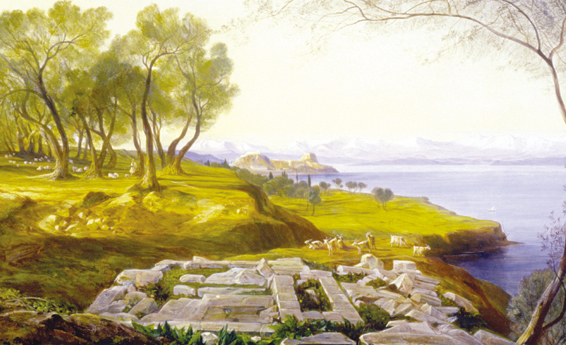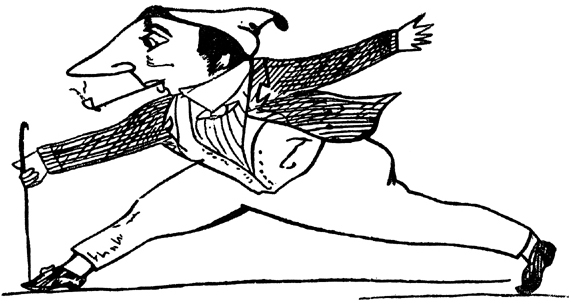Past Perfect: The Ridiculous and the Sublime
A master of light verse and painted landscapes, Edward Lear was also a man of the world
036

The English landscape artist and doggerel poet Edward Lear hardly cut a dashing figure. He was large and ungainly—“as uncombative as a tender girl,” according to fellow painter William Holman Hunt—and plagued by asthma, epilepsy and depression. But he also possessed great wit and a childlike love of the absurd. Lear was born in 1812 near London, the 20th child in a family of 21 siblings. At the age of 19, he published a highly regarded volume of drawings, Illustrations of the Family of Psittacidae, or Parrots, which brought him to the attention of Lord Stanley, later the Earl of Derby. Stanley invited Lear to his home near Liverpool to draw the birds and animals in his private menagerie. The whimsical young artist quickly became a family favorite, charming the Stanley children with jokes, puns and limericks—which were later published under the pseudonym Derry Down Derry in the wildly popular Book of Nonsense (1846). In 1837 Lear traveled to Italy, where he spent the better part of a decade honing his skills as a landscape painter. During the rest of his life, he traveled far and wide, sketching and painting the wonders of Corfu, Greece, Turkey, the Levant, India and Egypt. In 1888, at the age of 76, the self-proclaimed “Laureate of Nonsense” died in San Remo, Italy.
How pleasant to know Mr. Lear!
Who has written such volumes of stuff!
Some think him ill-tempered and queer,
But a few think him pleasant enough.
037
Corfu


Edward Lear set up residence on Corfu in 1855, using the island as a kind of base of operations for his many excursions around the Mediterranean and in the East. He sketched and painted various views, including Corfu from [the promontory of] Ascension (above), in which the town of Corfu and the hills of Albania can be glimpsed on the horizon. Lear’s experiences on the island found their way into his Book of Nonsense (1846), a collection of nonsense rhymes and humorous alphabets:
There was an Old Man of Corfu,
Who never knew what he should do;
So he rushed up and down, till the sun made him brown,
That bewildered Old Man of Corfu.
During Lear’s lifetime, the Book of Nonsense went into 19 editions (and is still in print). The reputation he won from penning such verses as “The Owl and the Pussycat” and eventually immortalized him.
038
Abydos

During his third tour of Egypt in 1867, Lear was stuck by the “sad, stern, uncompromising landscape—dark ashy purple lines of hills—piles of granite rocks—fingers of palm—& ever and anon astonishing ruins of oldest Temples.” When he reached Abydos, on the west bank of the Nile about 60 miles north of Thebes, he sketched the ruins above. Considered to be the burial place of Osiris, the Egyptian god associated with death, resurrection and fertility, the ancient necropolis and cultic center of Abydos flourished from predynastic times (late fourth millennium B.C.) through the Christian era. Lear relied on a technique he called “penning out” to capture the immediacy of his observations. He would first do a quick pencil sketch of the scenery before him and then reiterate the lines of his drawing in ink. Later he would add a watercolor wash. Today his artistic reputation is based on these impressionistic sketches rather than on his more conventionally rendered oil paintings.
039
Philae

Lear camped on the temple island of Philae, just above the first cataract of the Nile, for ten days during his first trip to Egypt in 1854. “It is impossible to describe the place,” he wrote, “than by saying it is more like a real fairy island than anything else I can compare it to. The Nile is divided here into several channels by other rocky islands, beyond you see the desert and the great granite hills of Assouan. The great Temple of Isis, on the terrace of which I am now writing, is so extremely wonderful that no words can give the least idea of it.” But he was not beyond adding a touch of lightness to the subject:
There was an Old Person of Philae,
Whose conduct was scroobious and wily;
He rushed up a Palm, when the weather was calm,
And observed all the ruins of Philae.
Lear produced at least 20 oil paintings of the site over the course of his career. The study above, Philae on the Nile (1855), is a view of the first pylon at the southern end of the Temple of Isis. Although the worship of Isis at Philae began as early as the reign of the Nubian pharaoh Taharqo (690–664 B.C.), the ruins of the sandstone temple pictured here date from the 30th Dynasty through the late Roman period (380 B.C.–300 A.D.). The temple was reassembled on a nearby island in the early 1970s when Philae was flooded by the rising waters of Lake Nasser.
The English landscape artist and doggerel poet Edward Lear hardly cut a dashing figure. He was large and ungainly—“as uncombative as a tender girl,” according to fellow painter William Holman Hunt—and plagued by asthma, epilepsy and depression. But he also possessed great wit and a childlike love of the absurd. Lear was born in 1812 near London, the 20th child in a family of 21 siblings. At the age of 19, he published a highly regarded volume of drawings, Illustrations of the Family of Psittacidae, or Parrots, which brought him to the attention of Lord Stanley, later the Earl […]
You have already read your free article for this month. Please join the BAS Library or become an All Access member of BAS to gain full access to this article and so much more.
